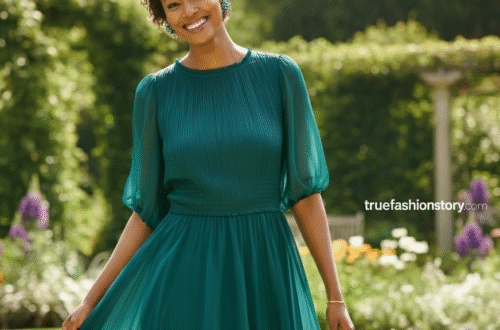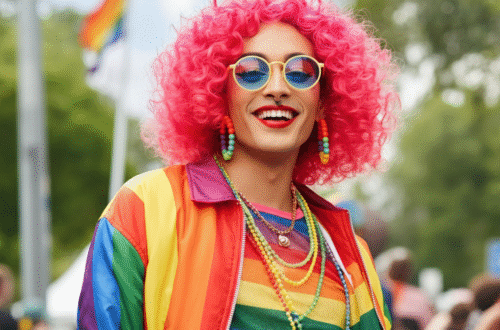Welcome to the vibrant world of Harajuku fashion! If you’ve ever seen photos of Japanese youth in incredibly creative, colorful, and boundary-pushing outfits, you’ve likely had a glimpse of this unique style. But Harajuku fashion is more than just clothing; it’s a powerful form of self-expression, a cultural movement, and a global inspiration. It’s born from the streets of the Harajuku district in Tokyo, a place where individuality reigns supreme.
This guide will walk you through everything you need to know about this dynamic fashion phenomenon. We will explore its history, break down its most popular subcultures, and even give you tips on how you can incorporate elements of Harajuku style into your own wardrobe. Prepare to dive into a universe of creativity where there are no rules but your own.
Key Takeaways
- Self-Expression is Key: Harajuku fashion is all about expressing your unique identity, interests, and creativity without fear of judgment.
- A Mix of Subcultures: It’s not one single style but an umbrella term for many diverse subcultures, from the sweet Lolita to the dark Visual Kei.
- DIY and Thrifting: A core principle of Harajuku is the “do-it-yourself” spirit, often involving customizing thrifted items to create one-of-a-kind looks.
- Global Influence: While born in Tokyo, Harajuku’s influence has spread worldwide, inspiring designers, artists, and fashion lovers everywhere.
What Is Harajuku Fashion?
At its core, Harajuku fashion is a mix of numerous styles and subcultures that have originated in the Harajuku district of Shibuya, Tokyo. It’s not one defined look but a vibrant, ever-changing collage of personal expression. Imagine a place where you can be a gothic vampire one day and a pastel-colored fairy the next—that’s the spirit of Harajuku. This style defies mainstream trends and instead celebrates individuality.
Participants in Harajuku fashion are not just wearing clothes; they are making a statement. They mix and match items from different eras, thrift stores, and high-end boutiques to create an outfit that is entirely their own. It’s about freedom from the strict social norms that can be prevalent in Japanese society. The streets near Harajuku Station, particularly Takeshita Street, serve as a runway for these incredible displays of creativity. It’s a place where fashion is art, and everyone is an artist.
The History and Origins of Harajuku Style
The roots of Harajuku fashion can be traced back to the post-war era. After World War II, American soldiers and their families were housed in the Washington Heights area of Tokyo, near Harajuku. Young Japanese locals became fascinated by the different, Western styles they saw. This curiosity sparked a desire to break away from traditional Japanese attire and experiment with new looks. Shops catering to this new interest began popping up, and the area slowly transformed into a youth culture hub.
The real explosion of Harajuku fashion as we know it began in the 1980s. The pedestrianization of Omotesandō, a major street in the area, allowed young people to gather and showcase their unique styles. This era saw the rise of street style magazines like FRUiTS, which documented the incredible outfits seen on the streets, further popularizing the movement. It became a social phenomenon where fashion was a form of rebellion and a way to build community with like-minded individuals.
Why Is It Called Harajuku Fashion?
The name is quite literal! It’s called Harajuku fashion because it originated and continues to thrive in the Harajuku district of Tokyo. This area, centered around Harajuku Station, is the epicenter of this fashion movement. For decades, it has been the go-to meeting spot for young people who want to express themselves through their clothing choices.
The name signifies more than just a location; it represents a spirit of freedom and creativity. When someone mentions Harajuku fashion, they are referring to the eclectic and non-conformist styles seen on the streets of this specific neighborhood. It has become a brand in itself, synonymous with Japan’s most forward-thinking and experimental youth culture. The name acts as a banner for all the sub-styles that fall under its wide umbrella, connecting them all back to their geographical and spiritual home.
The Core Principles of Harajuku Style
While Harajuku fashion is incredibly diverse, a few core principles unite its many forms. Understanding these ideas is key to grasping what the movement is all about.
Individualism Over Trends
The most important rule of Harajuku is that there are no rules. It’s about wearing what you love, not what’s currently popular in mainstream magazines. This could mean combining vintage pieces with handmade accessories or clashing patterns and colors in a way that would be considered a “fashion don’t” by conventional standards. The goal is to create a look that is 100% you.
The Power of DIY and Customization
A huge part of Harajuku culture is the “do-it-yourself” (DIY) ethic. Many of the most impressive outfits are not bought off the rack. Instead, they are carefully constructed from thrifted items, customized pieces, and handmade accessories. This could involve painting on a denim jacket, adding patches and pins, or even sewing a garment from scratch. This approach makes each outfit truly unique and personal. For more style inspiration, you can always check out resources like truefashionstory.comBlog.
Layering and Accessorizing
More is more in the world of Harajuku. Layering is a fundamental technique used to add depth, texture, and complexity to an outfit. This might mean wearing a t-shirt over a long-sleeved shirt, a dress over pants, or multiple skirts at once. Accessories are equally important. It’s common to see people adorned with dozens of bracelets, necklaces, hair clips, and pins. Every accessory adds another layer to the story their outfit is telling.
Popular Harajuku Fashion Subcultures
Harajuku is not a single style but a collection of many. Here are some of the most well-known subcultures you might encounter.
Lolita
Lolita fashion is one of the most famous Harajuku sub-styles. Inspired by Victorian and Rococo aesthetics, it is characterized by its modesty and focus on a cute, doll-like appearance.
- Sweet Lolita: Uses pastel colors, bows, lace, and cute prints featuring things like sweets, fruits, and animals.
- Gothic Lolita: Combines the cute Lolita silhouette with a darker, gothic aesthetic. It uses black, dark reds, and purples, with motifs like crosses, bats, and coffins.
- Classic Lolita: A more mature and elegant take on the style. It uses muted colors, floral prints, and A-line silhouettes for a more historical look.
Decora
Decora is all about bright colors and an abundance of accessories. The goal is to be as decorated as possible. A typical Decora outfit starts with a simple base, like a hoodie and tutu, and then layers on an explosion of colorful items. This includes countless plastic hair clips, beaded necklaces, bracelets, and cute character merchandise like Hello Kitty or Pokémon. The philosophy is one of childlike fun and overwhelming cuteness.
Visual Kei
Influenced by Japanese glam rock and metal bands from the 1980s, Visual Kei is a dramatic and androgynous style. It features elaborate hairstyles, heavy makeup, and punk or gothic-inspired clothing. Think dark colors, leather, chains, and platform boots. The focus is on creating a striking visual image, often with a theatrical flair. Each band and fan puts their own unique spin on the look.
Fairy Kei
Fairy Kei is a style based on a dreamy, nostalgic view of the 1980s. It uses a palette of pastel colors like mint green, lavender, baby pink, and light blue. Motifs often include vintage cartoon characters like My Little Pony, Care Bears, and Rainbow Brite. Outfits typically feature fluffy tutus, oversized sweaters, leg warmers, and sneakers. It’s a soft, whimsical style that feels like a sweet daydream.
Subculture Comparison Table
|
Style |
Key Elements |
Color Palette |
Vibe |
|---|---|---|---|
|
Sweet Lolita |
Ruffles, lace, bows, bell-shaped skirts |
Pastels, light pinks, blues |
Doll-like, innocent, cute |
|
Gothic Lolita |
Crosses, lace, platform shoes, corsets |
Black, dark red, deep purple |
Elegant, dark, mysterious |
|
Decora |
Plastic accessories, layers, face stickers |
Rainbow, neon, bright colors |
Fun, loud, childlike |
|
Visual Kei |
Wild hair, heavy makeup, leather, chains |
Mostly black with pops of color |
Androgynous, dramatic, rock |
|
Fairy Kei |
Tutus, leg warmers, vintage cartoons |
Pastels, soft neons |
Dreamy, nostalgic, whimsical |
How to Incorporate Harajuku Style into Your Wardrobe
You don’t have to move to Tokyo to enjoy Harajuku fashion. You can easily incorporate elements of this creative style into your everyday look.
Start Small with Accessories
The easiest way to start is with accessories. Try adding a few colorful hair clips, a statement necklace, or a fun character-themed keychain to your bag. This allows you to add a pop of Harajuku personality without completely changing your style. Layering bracelets or wearing fun, patterned socks is another great way to begin experimenting.
Embrace Layering
Experiment with layering different pieces from your existing wardrobe. Try wearing a graphic tee over a long-sleeved mesh top or a slip dress over a pair of jeans. Playing with different combinations can help you create a unique silhouette and add visual interest to your outfit. Don’t be afraid to mix patterns and textures.
Visit Thrift Stores
Thrifting is at the heart of the Harajuku spirit. Head to your local second-hand shop to find unique pieces that you can customize. Look for vintage blouses, oversized jackets, or interesting skirts. You can add your own touch with patches, paint, or embroidery to make them truly one-of-a-kind.
Frequently Asked Questions (FAQ)
Q1: Is Harajuku fashion still popular in 2025?
Absolutely! While some specific trends have evolved, the spirit of Harajuku is very much alive. Young people continue to gather in the district to showcase their unique styles. The fashion landscape is always changing, with new subcultures emerging, but its role as a hub for self-expression remains strong.
Q2: Do you have to be Japanese to wear Harajuku fashion?
Not at all! Harajuku fashion is a global phenomenon loved and worn by people all over the world. It’s a form of self-expression, not cultural appropriation, as long as it’s done with respect and appreciation for its origins. Fashion is for everyone to enjoy.
Q3: Can men participate in Harajuku fashion?
Yes! Harajuku style is for all genders. Many of its subcultures, like Visual Kei and punk, are very popular with men. Androgyny is also a common theme, with many styles encouraging people to dress in a way that blurs traditional gender lines.
Q4: Where can I buy Harajuku-style clothing?
While the best place is Harajuku itself, many online stores specialize in Japanese fashion and ship worldwide. Websites like YesStyle, and specialized brand sites for labels like Angelic Pretty (for Lolita) are great places to start. Thrifting and platforms like Depop are also fantastic for finding unique pieces to create your Harajuku look.
Conclusion
Harajuku fashion is so much more than a trend; it’s a celebration of individuality, creativity, and freedom. It’s a colorful reminder that fashion should be fun and that the most important rule is to be true to yourself. Whether you’re drawn to the sweet pastels of Fairy Kei or the dark elegance of Gothic Lolita, there is a place for you in the world of Harajuku.
So, don’t be afraid to experiment. Mix those patterns, layer those accessories, and wear that color combination that makes you happy. By embracing the spirit of Harajuku, you can turn your wardrobe into a canvas for self-expression and bring a little bit of Tokyo’s creative energy into your everyday life.





